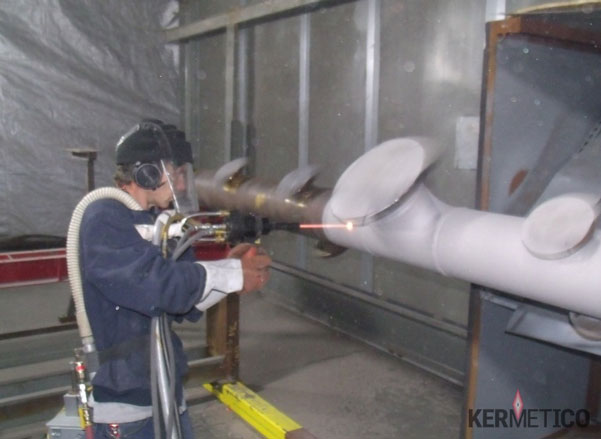HVAF H₂S Resistant Coating to Protect Pressure Vessels from Corrosion

A refinery sulphur recovery plant operates multiple pressure vessels exposed to H₂S and CO₂ corrosion due to the presence of hydrogen sulphide and carbon dioxide containing fumes and moisture in varying temperature conditions. Categorized as pressure vessels, the towers, absorbers, condensers and channels are frequently made of mild carbon steel with low corrosion resistance.
Kermetico HVAF thermal spray equipment and technology allows depositing dense metal H₂S resistant coating to mitigate H2S and CO2 corrosion of pressure vessels and piping.
Coatings Protecting Refinery Pressure Vessels from H2S Hydrogen sulphide Stress Cracking (SSC)
There is a need to extract hydrogen sulphide from oil and gas in petrochemical processing. H2S corrosion, or sour corrosion, occurs when H2S gas reacts with carbon steel in a wet and sour environment. In the case of sour corrosion, hydrogen atoms formed during the corrosion process at the metal surface diffuse through the surface of the carbon steel and become trapped at laminations caused by voids and nonmetallic inclusions. When atomic hydrogen is absorbed by solid metals, hydrogen-induced cracking (HIC) can result. The hydrogen atoms combine to form molecular hydrogen (H2), which creates pressure from within the metal. Trapped H2 gathers at these locations and forms blisters as pressure builds. Eventually, cracking occurs when several hydrogen blisters connect in the base metal.
Several mitigation methods are known to prevent sulphide stress cracking and hydrogen induced corrosion. One is to perform a stress-relieving treatment on the metal to reduce hardness levels to acceptable levels in an annealed microstructure. A second method is to clad the carbon steel linings and welds with a corrosion-resistant alloy. Cladding the interior of a treatment column with a thermal spray-applied corrosion resistant alloy would form a barrier between the carbon steel and the sour process fluid and prevent sour corrosion, which would stop the formation of hydrogen atoms and their subsequent migration into the steel. Unlike a sacrificial thermal spray coating that is designed to corrode preferentially to protect the substrate, a barrier thermal spray coating for this application needs to completely block the fluid’s corrosive constituents from rusting the base metal, so porosity and density of the applied coating are important considerations for preventing corrosion of the substrate. Kermetico HVAF thermal spraying is an industrial coating process that uses a chemical (flame) heat source to preheat a powder coating material and spray it onto surfaces. Depending on the corrosion activity of the environment and the planned equipment life-cycle, different HVAF coatings could be applied onto the surface from stainless steel to Hastelloy-type.
A Case of a Petrochemical Refinery Sulphur Condenser Sour Gas Corrosion
Mild steel petrochemical equipment treating sour components is subject to severe H2S and SO2 corrosion. The sulphur condenser outlet channel suffers extensive pitting due to dew point corrosion caused by condensation of sulphuric acid on the “cold spots” where the metal surface temperature drops below 120°C (248°F).
After successful testing in boiling concentrated sulphuric acid media the Hastelloy – type Kermetico HVAF coating of 0.25 mm (0.010”) thickness was specified for application on the complete inner surface of the outlet channel (1.8 m (6’) diameter, 2.7 m (9’) long), with a gas outlet (0.76 m (2.5’) diameter, 0.3 m (1’) long) welded to it as well as on the channel cover (1.8 m diameter). We have robotically HVAF grit blasted the inner surface of the channel with the AK7 system, and have robotically applied the coating everywhere except for the masked areas for welding of the demister frame and plates.

Following the welding of the de-mister support structure, the welds were sprayed with the manual Kermetico HVAF AK-HH gun. After installation of the channel at the plant, the customer flame-cut a hole in the bottom through the coating and welded the liquid sulphur outlet to it.
Finally, the corrosion resistant coating was applied over the cut area and inside the liquid sulphur outlet with a hand-held AK-HH gun on-site. After five years in operation, the H2S resistant coatings on the channel and cover are intact and remain in service.

Spraying a Hastelloy C-type coating onto a Manifold with the Kermetico HVAF AK-HH Handheld Gun
For more information, Click Here.

